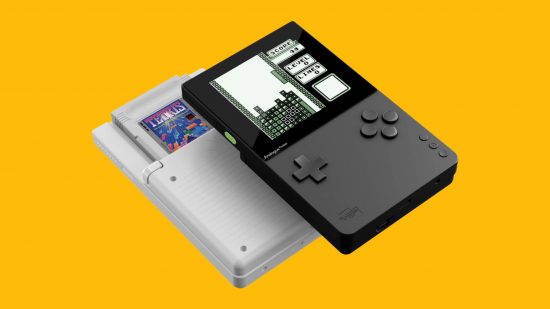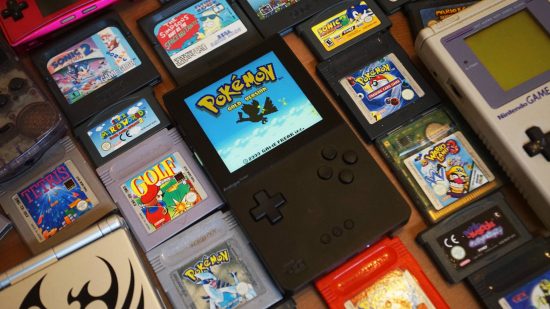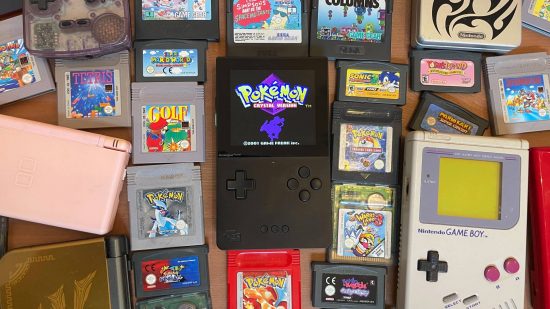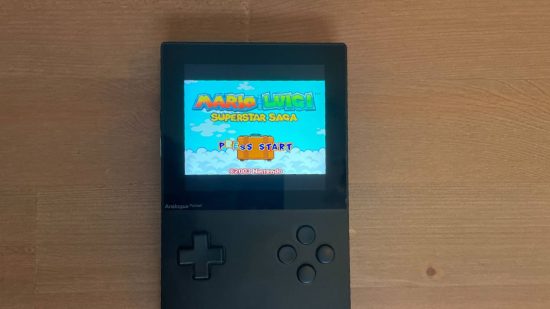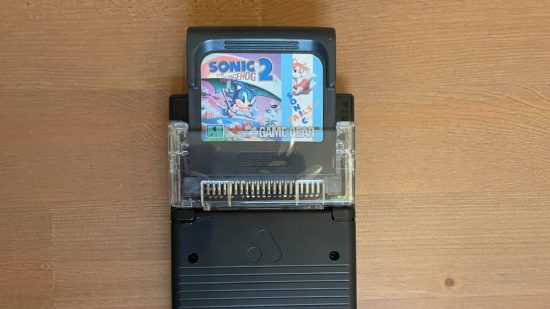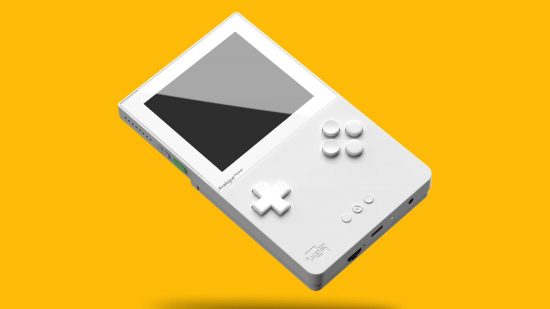Our Verdict
A distinctly premium device designed for enthusiasts, the Analogue Pocket achieves everything it sets out to do with flying colours. A gorgeous screen, premium feeling device, and a plethora of features make this the best way you could ever hope to play Game Boy games. But whether you can deal with the price or the wait is entirely up to you.
- Top-tier retro gaming
- Fantastic form factor
- No emulation
- Retro only
- No ROM compatibility
Retro gaming is only getting better over the years, as what was once something of a niche pursuit is being strengthened by a string of quality third-party devices, allowing consumers to play and experience classic games in modern ways, and Analogue could be the one leading the charge.
After success with devices like the Analogue Super NT and the Analogue Mega Sg, which play SNES and Mega Drive games natively, respectively, the retro-focused company turned its attention to handheld gaming. In comes the Analogue Pocket, a stunning device that’s clearly modelled on the original Game Boy and can natively play actual cartridges through actual hardware. Thanks to this innovative line of thinking, you can bring your old Game Boy, Game Boy Colour, and Game Boy Advance games to life like never before.
It doesn’t stop there though, as you can also purchase cartridge adapters to play Game Gear, Neo Geo Pocket, and Atari Lynx cartridges on the same device. The main selling point here, as well as the convenience, is a gorgeous 3.5”, 615 ppi, LCD screen that runs at ten times the resolution of the original Game Boy, giving classic games a vibrant, pixel-perfect facelift that you have to see to believe. But at $219.99 (before shipping or any extras like the dock)/ is it worth the price, or, more importantly, the wait? Let’s dive into our Analogue Pocket review to find out.
Full disclosure, Analogue didn’t send us an Analogue Pocket for review. Instead, I ordered one when pre-orders became available back in December of 2022, and my unit arrived around December 20th 2023, over a year after ordering. This is a luxury device and a complicated machine to reproduce, so as demand continues to sky-rocket, it’s no surprise that waiting times are an issue. But it’s something to consider, especially with so many other handheld devices on the market.
I already had a pretty sizable collection of Game Boy games thanks to the fact I’m old and actually grew up in the 90s. Of course, ordering the Pocket back in 2022 meant I had a whole year to also add to it, so you had better believe that by the time my order turned up, I had built an impressive library of GB, GBC, GBA, and Game Gear games all ready and waiting to be tested to their fullest.
For me, this is a really important thing to distinguish off the bat. Are you a huge fan of the Game Boy consoles? Do you have a vast collection of games? Do you actually play them? Then yes, the Analogue Pocket might be for you, but if you’re not an enthusiast, then it becomes a much tougher sell. So first of all, let’s get into what the Analogue pocket does right.
It’s hard to convey in pictures, but the main appeal of the Pocket is undoubtedly the crystal-clear 3.5” LCD screen, protected by gorilla glass, and with a 1600×1440 resolution that stretches Game Boy games perfectly to ten times the resolution of the originals. Pokémon Red is the first game I loaded up, and the clarity is truly breathtaking. The whites can be blindingly bright, but the sharpness of the pixels makes this feel like the best way you could ever hope to play a Game Boy game.
There’s nothing like it, and with the form factor of the Game Boy as well, it truly hits all the nostalgia buttons in the brain. Playing black-and-white games naturally gives quite a sharply contrasted image, but Game Boy Colour titles come to life with a vibrancy and level of detail that blows me away. Playing Pokémon Crystal on the Pocket nearly reduces me to tears, and I wish I was joking.
As you move up the generations, the colour given to the often washed-out GBA games similarly gives them a much-needed boost. Titles that are dark and dreary on original GBA hardware are now the colourful and saturated visual masterpieces they should be, with titles like The Legend of Zelda: Minish Cap and Metroid Fusion especially looking like they could release on modern hardware today just as they are. The GBA era goes down as an incredible era for pixel art, and the Pocket helps these games realise their potential.
One issue with GBA titles is that they have a different aspect ratio, so the Pocket adds black bars to the top and bottom of the screen. You can choose to change the way the pixels are shown to squash or stretch the image, but given the form factor, there isn’t a satisfying way to fill the screen with GBA titles that doesn’t compromise on the visuals of the game. However, if this is a sacrifice that Analogue made to create the ultimate Game Boy device, it’s a small inconvenience.
So the screen is one thing, but hardcore Game Boy fans will want to know how these titles run. Well, crucially, it’s important to reiterate that the Analogue Pocket doesn’t run cartridges through any emulation. The device actually uses hardware to play them, so the performance is as perfect as it could be. I have tested Game Boy, Game Boy Colour, Game Boy Advance, and Game Gear cartridges, and absolutely every single one plays and runs like a dream.
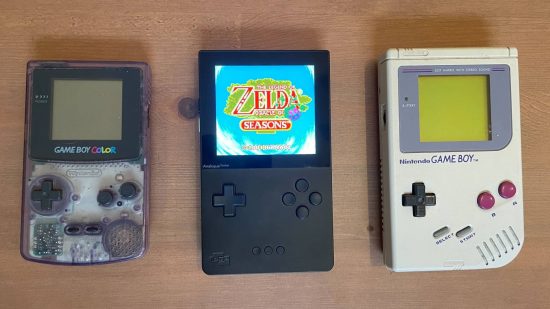
The Analogue Pocket also has quite a few tricks up its sleeve, as there are options to adjust the video and sound in pretty much every type of game. For instance, you can play Game Boy cartridges in a variety of colour palettes or display modes, with either the typical greyscale or some mimicking the palettes available on the Game Boy Colour.
There aren’t many similar options for Game Gear or GBA titles, but you can adjust brightness and sharpness. Every system does have the option to move between either a pixel-perfect visual mode or one with scanlines to represent the original hardware, and while I didn’t use it, I can appreciate that the option is there.
If you want to splash out the extra cash, there’s also the option to use the Analogue pocket dock to play it on TV, and this does exactly what it says on the tin. Thanks to the great performance of the device, this is a fantastic way to play Game Boy games on the big screen, and it’s very straightforward to dock the device, as well as sync BlueTooth controllers like the 8BitDo Pro 2 or the Ultimate. Not everyone needs it, but it works flawlessly if that’s something you are after.
So, that’s everything the Analogue Pocket does well. But it’s important to note that the things it does well, it does near perfectly. This is the best modern device to play Game Boy games by a wide distance, and in trying to be the ultimate Game Boy device, the form factor is clearly meant to be based on the Game Boy Colour, with a size smaller than the original grey brick, but much bigger than something like the Game Boy Lite and Pocket.
The Analogue Pocket is much heavier, though it does feel well made with a real weight to the materials, but it can become uncomfortable in longer play sessions. Meanwhile, while the face of the device has four buttons that allow users to play GB and GBA titles accurately, and they feel great, the shoulder buttons leave a lot to be desired. They’re too thin to feel comfortable resting on, and they need a hefty push to activate. I wish they were a little bit ‘clickier’ and they would be much more comfortable if they stuck out just a tiny bit more.
Also, while it shouldn’t be an issue really if you use one of the cartridge adapters like the Game Gear one, it sits on top of the shoulder buttons, rendering them unusable. Given the width of the cartridges, I don’t know what the workaround is, and theoretically, no games that use the adapters should use the shoulder buttons, but it’s an annoyance.
Another issue to consider is the price, as well as the delivery time. If you’re in the US, it isn’t as much of an issue, but as I’m based in the UK ,I got hit with a £70 customs charge on top of the hundreds of dollars I dropped on the device, the dock, and the Game Gear adapter. This is a luxury device, so I recommend that you have yourself a long and hard look in the mirror to ask if this is for you first.
Finally, as the Analogue Pocket runs on FPGA hardware, community members have created cores to run games and devices through emulation. With some work, anyone can play Mega Drive, SNES, and titles from other platforms through emulation. The Analogue Pocket is a fantastic way to play a lot of these games thanks to the gorgeous screen, and the portability similarly adds a lot to the experience.
After nearly a month, I’m utterly besotted with my Analogue Pocket, but I’m also aware of its flaws. However, any game that uses the shoulder buttons makes things much more difficult though, and shifting your hands makes the already heavy device sometimes unwieldy to hold for long sessions. You can always fire it up on the doc, of course, (if you bought one), but playing GBA games could be a slightly better experience. Though I’m sure after the success of the device, we’ll likely get an Analogue Pocket GBA down the line.
Nonetheless, playing Game Boy games has never been better, and going through my old library on that beautiful screen is a godsend. Even just the ability to put the device to sleep and pick up games later is a blessing, and in a portable form factor, it’s just incredible.
Whether you need an Analogue Pocket is entirely down to how invested you are in the Game Boy library. This device costs a lot of money for something designed to only do one or two things, but if you love GB games, then this is an absolutely essential purchase and a beautiful way to experience some classics. The price and waiting times are tough to stomach, so I don’t know how much I can recommend it to anyone with a mild interest, but any handheld gaming enthusiast with a stack of games to play will be in heaven.
